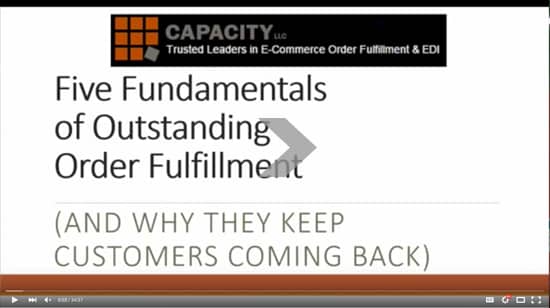Fulfillment Fundamentals: The Final Mile
Back in April, we held a webinar to explore the fundamental elements of order fulfillment. Capacity's co-founder and CSO Thom Campbell identified five key areas to focus on if you truly want to develop a fulfillment process that keeps customers coming back to your business time and time again.
To follow up on the event we've been unpacking each of these elements in more detail. To end this week we look at the importance of what many call the "final mile" of your fulfillment: what it costs to get a product into the hands of your customer, and how it looks and feels when it gets there.
You can read the rest of the entries in this compelling series under the tag Fulfillment Fundamentals.

Get it there, so you can bring customers back for more.
When all is said and done, even the best fulfillment systems in the world don't make any difference to your customer if the delivery does not happen how and when they expect it.
This is the final mile of fulfillment, and it is worth going much more than the extra mile to make it happen without a hitch. As always, cost makes for an important consideration, but at the same time, never underestimate the value of a customer who wants to keep coming back to do business because they trust you to deliver.
“There is no finish line,” if you swear by the philosophy of Nike. This concept should always come into play when it comes to serving your customer.
Examine the Economics of Shipping
In the cold light of accounting, reality can limit the level of delivery service you can offer your customer. If it costs $15 to ship a parcel via UPS/FedEx, that may not be a viable option for your brand needs.
However, there is such a thing as hybrid delivery service, which may provide a viable solution at roughly half the cost. These include UPS’s Mail Innovations & SurePost and FedEx SmartPost, which induct into their networks and then provide final mile service via the Postal Service. We unpacked these hybrid delivery services in more detail earlier this year.
This type of set-up can work well from a cost perspective. However, we all knowthat you get what you pay for, so what are you paying for with these services? Some considerations:
- Improved tracking when compared to USPS Priority Mail, which is basically a binary tracking feature (it got there or it didn’t; not so helpful);
- Some reports we have seen detail an increase in transportation-related customer service issues, to the tune of a 1-2% increase in complaints;
- Cost savings amounting to tens of thousands of dollars per month, in some cases;
- For some brands, the reputation of USPS simply makes them an inappropriate delivery option that does not align with their brand image or reputation. Quality products and luxury brands, to name just two.
Which option you choose will depend heavily on your product and your tolerance for customer service issues over cost savings. On the former, remember our earlier lesson that, in the digital age of online reviews and social networks, complaints are no longer limited to the individual; they're widely shared with others and can live on long after the original issue has been resolved.

Going the Extra Mile
Back around 2006 or 2007, we came across a New York Times’ article that started the ball rolling on an excellent "final mile" story.
Times reporter Clyde Haberman wrote about a woman, Marcelle Shriver, who had a request from her son Todd, then serving our armed forces in Ramadi, Iraq. His unit had learned from some Marines the trick of using Silly String, a gag gift which squirts an aerosol jet of foam, to detect hidden wires used to trigger improvised explosive devices. They were understandably keen to get some of this product, which was unavailable in the country.
Marcelle, being a resourceful American mom, managed to stockpile a huge supply of the stuff from donations and grassroots efforts. But she had a major problem. Aerosols are considered a Hazardous Material, also known as HazMat. The generous friend who was warehousing the product was not qualified to ship HazMat.
Capacity CSO Thom Campbell read this with great interest and growing anticipation, as we are a recognized shipper with the Department of Homeland Security. Our managers are qualified by IATA, the international regulatory body overseeing this, to ship HazMat. He called Marcelle to tell her Capacity could help.
With additional input and assistance from transport partners like YRC trucking, and our ‘will not be denied’ VP of Logistics Tony Ruiz, we collected, packaged and shipped some 80,000 cans of Silly String to our troops in Iraq.
The takeaway is that Marcelle had absolutely all the right ingredients for a great service, but she could not cover the final mile ( which happened to be several thousand miles in her case, but the analogy stands!)
Alongside our partners, Capacity could make it happen. When an opportunity to do something like this presents itself, we jump at the chance to go outside of our normal operations. We were just lucky we could, especially for such a noble cause. It was a pleasure to build on all of Marcelle's hard work to get it over the goal line.
As we regularly tell people, ours is not a glamorous industry, but what we do is a key piece in the supply chain puzzle.
The final mile plays a major part in making your customers happy, and needs to be approached with just as much care and consideration as the sexier parts of your brand.